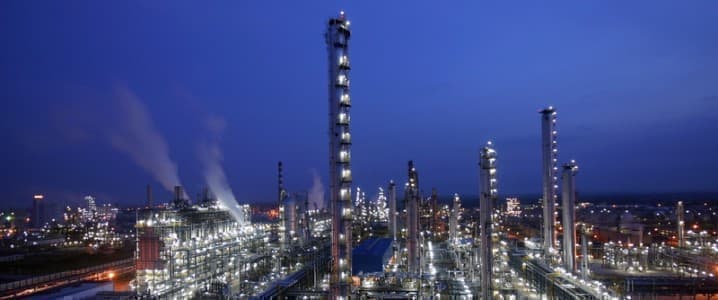China's Sinopec has developed a steam-cracking technology to convert oil directly into high-demand petrochemical products such as ethylene and propylene, cutting costs and production times as well as significantly reducing carbon emissions. Could this be the low-carbon answer to petrochemical production, as the global need for these products keeps increasing even as demand for crude wanes?
The China Petroleum & Chemical Corporation, or Sinopec, announced this month that is has successfully tested its project, the "Technological Development and Industrial Application of Light Crude Oil Cracking into Ethylene". Through the ‘crude to chemicals’ development, Sinopec hopes to expand China’s petrochemical industry as well as achieving low-carbon operations objectives. This is the first example of successful steam cracking technology in China, with ExxonMobil being the only company in the world to have accomplished the industrial application of steam-cracking technology. Sinopec is currently in the process of applying for domestic and international patents for the technology.
Steam cracking works by skipping the standard crude oil refining process by instead converting the crude directly into chemical products, saving time and resources, and decreasing the release of carbon emissions from the method thanks to the reduced energy consumption required to fuel the process. The new technology is expected to produce almost 500,000 tonnes of chemical products, 400,000 tonnes of which are high-value ethylene, propylene, light aromatics, and hydrogen, from 1 million tonnes of crude oil.
But it’s not just China that is making advances in the crude to chemicals area, as Saudi’s Aramco has also outlined similar plans for converting crude oil to light olefins, such as ethylene and propylene, using a single-reactor system instead of steam cracking. Aramco is working with researchers from the King Abdullah University of Science and Technology (KAUST) to develop the technology, investing heavily in the project as demand for petrochemicals is expected to continue rising while demand for traditional fuel decreases in the face of renewable energy developments. Petrochemicals could provide a much-needed use for crude in a world that’s slowly turning its back on fossil fuels.
KAUST Professor of Chemical Engineering and Director of the KAUST Catalysis Centre, Jorge Gascon explains the development. "Altogether, our results demonstrate that the search for alternative reactor-engineering concepts, when accompanied by complementary multifunctional catalyst development, is worth exploring for process intensification." "This new process has the potential to reduce the need for distillation and steam cracking units," he added.
As part of its aim for net-zero carbon emissions by 2060, Saudi Arabia hopes to use carbon capture and storage (CCS) technology as well as low-carbon oil production to support the ongoing expansion of its oil and gas industry. Saudi’s petrochemical company Sabic hopes to reduce greenhouse gas emissions by 20 percent by 2030, on 2018 figures. The development of CCS technology to convert carbon into grey hydrogen, as well as the development of cleaner green hydrogen projects, will support this objective.
Thailand is also making strides in its low-carbon petrochemical development. This month, PTT Global Chemical (PTTGC), the country’s largest petrochemical company, announced plans to invest up to $25 billion to achieve carbon neutrality by 2050, hoping to make emissions reductions of 20 percent by 2030.
PTTGC will no longer be building new plants in Thailand but will focus on de-bottlenecking existing operations, enhancing digital technology across the firm, and reducing feedstock consumption to improve output. PTTGC is already investing in CCS technology but greater funding towards new crude to chemical technologies could significantly improve the company’s petrochemical operations while supporting its goal of net-zero.
With analysts predicting petrochemicals will be the big winner in the coming decades, particularly when it comes to the ongoing use of fossil fuels, it’s no surprise several countries are competing for their piece of the pie. Coming out the other side of oil’s toughest year, it surprised many to see that petrochemical company revenues bounced back in the third and fourth quarters of 2020, going on to make profits throughout 2021. This is largely because of the increased demand for consumer packaging, cleaning and hygiene products, and personal protective equipment, requiring ethylene, polyethylene, and polypropylene as part of the manufacturing processes.
Thanks to an increased demand for products requiring petrochemicals, including industrial applications such as construction, automotive, aviation, food, electrical, paint and coatings, and paper, the global petrochemical market could achieve a CAGR of 5.1 percent between 2021 and 2030. The current value of the worldwide petrochemical market was estimated at around $452.9 billion in 2020, a figure that could increase to $729 billion by 2030 if the current trend continues.
With a strong outlook for the petrochemical market and the potential to develop low-carbon petrochemical production methods, on top of low-carbon oil production supported by CCS technologies, energy firms and governments around the world are racing to establish a strong, low-carbon petrochemical portfolio to position themselves securely in the international market as demand climbs.
By Felicity Bradstock for Oilprice.com
More Top Reads From Oilprice.com:
- How A Biden SPR Release Will Send Oil Prices Even Higher In 2022
- Tiny Reactors Could Make Nuclear Power 50% Cheaper
- The Real Reason Big Oil Is Refusing To Boost Production


















